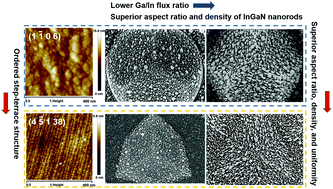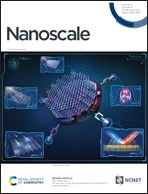Insight into the Ga/In flux ratio and crystallographic plane dependence of MBE self-assembled growth of InGaN nanorods on patterned sapphire substrates†
Abstract
A controllable self-assembled growth using molecular beam epitaxy (MBE) of dense, uniform, and high-aspect-ratio InGaN nanorods (NRs) is achieved through regulating the Ga/In flux ratio and employing high Miller index planes of patterned sapphire substrates (PSSs). It is clearly demonstrated that both the low Ga/In flux ratio and high Miller index plane of PSS patterns facilitate the three-dimensional growth mode for InGaN NRs and simultaneously suppress NR coalescence. A lower Ga/In flux ratio favors a higher density, a larger aspect ratio, and a smaller coalescence degree of InGaN NRs through enhancing axial growth and inversely suppressing radial growth. The specific surface structures of high Miller index planes, e.g., the well-organized step-terrace and irregular bulge structures, critically affect the morphology, dimensions, density, and crystallographic orientation of MBE self-assembled NRs. In particular, the narrow and ordered step-terrace structure in the C3-plane—(4 ![[5 with combining macron]](https://www.rsc.org/images/entities/char_0035_0304.gif) 1 38) plane—on a hexagonal pyramid favors the highest density, largest aspect ratio, and best uniformity of semipolar InGaN NRs, thus contributing to optimal photoluminescence performance. A thorough understanding of the mechanism of the effect of the Ga/In flux ratio and crystallographic plane on the MBE self-assembled growth behaviour of InGaN NRs was gained through experimental and theoretical exploration. This work contributes towards a deep understanding of the MBE self-assembled growth mechanism and controllable fabrication of dense, well-separated, and uniform InGaN NRs, thus contributing to the enhanced performance of NR-based optoelectronic devices.
1 38) plane—on a hexagonal pyramid favors the highest density, largest aspect ratio, and best uniformity of semipolar InGaN NRs, thus contributing to optimal photoluminescence performance. A thorough understanding of the mechanism of the effect of the Ga/In flux ratio and crystallographic plane on the MBE self-assembled growth behaviour of InGaN NRs was gained through experimental and theoretical exploration. This work contributes towards a deep understanding of the MBE self-assembled growth mechanism and controllable fabrication of dense, well-separated, and uniform InGaN NRs, thus contributing to the enhanced performance of NR-based optoelectronic devices.



 Please wait while we load your content...
Please wait while we load your content...